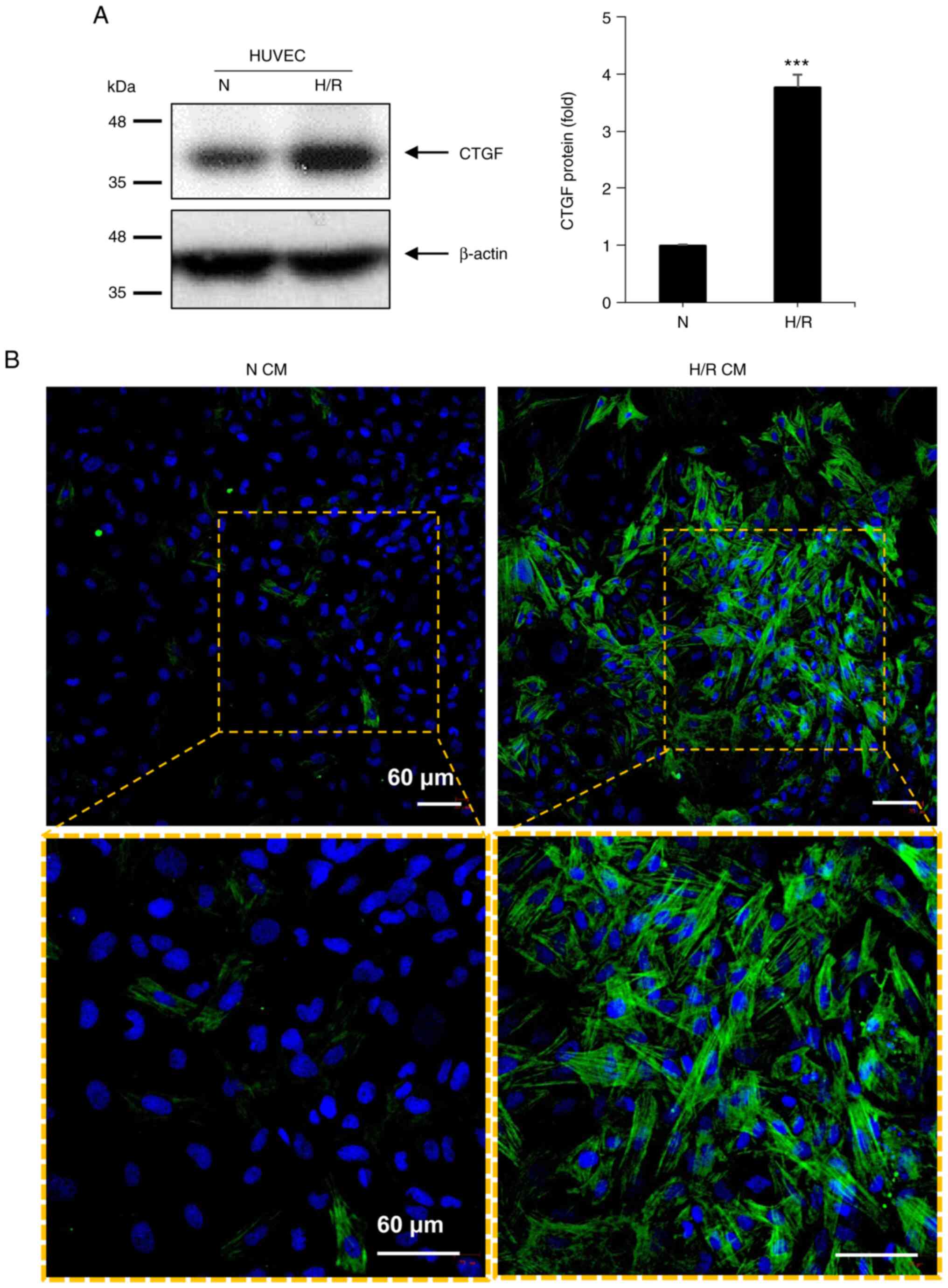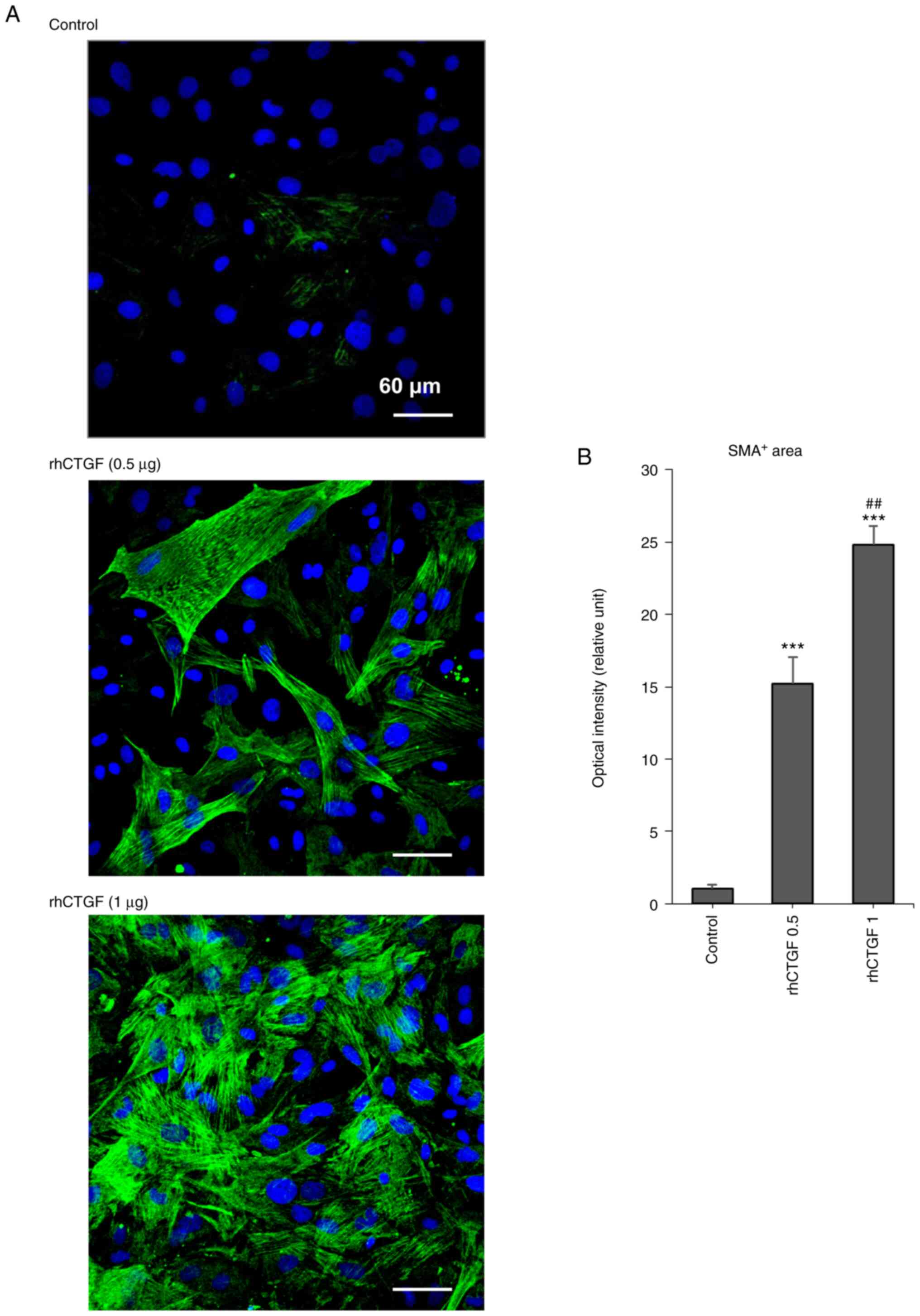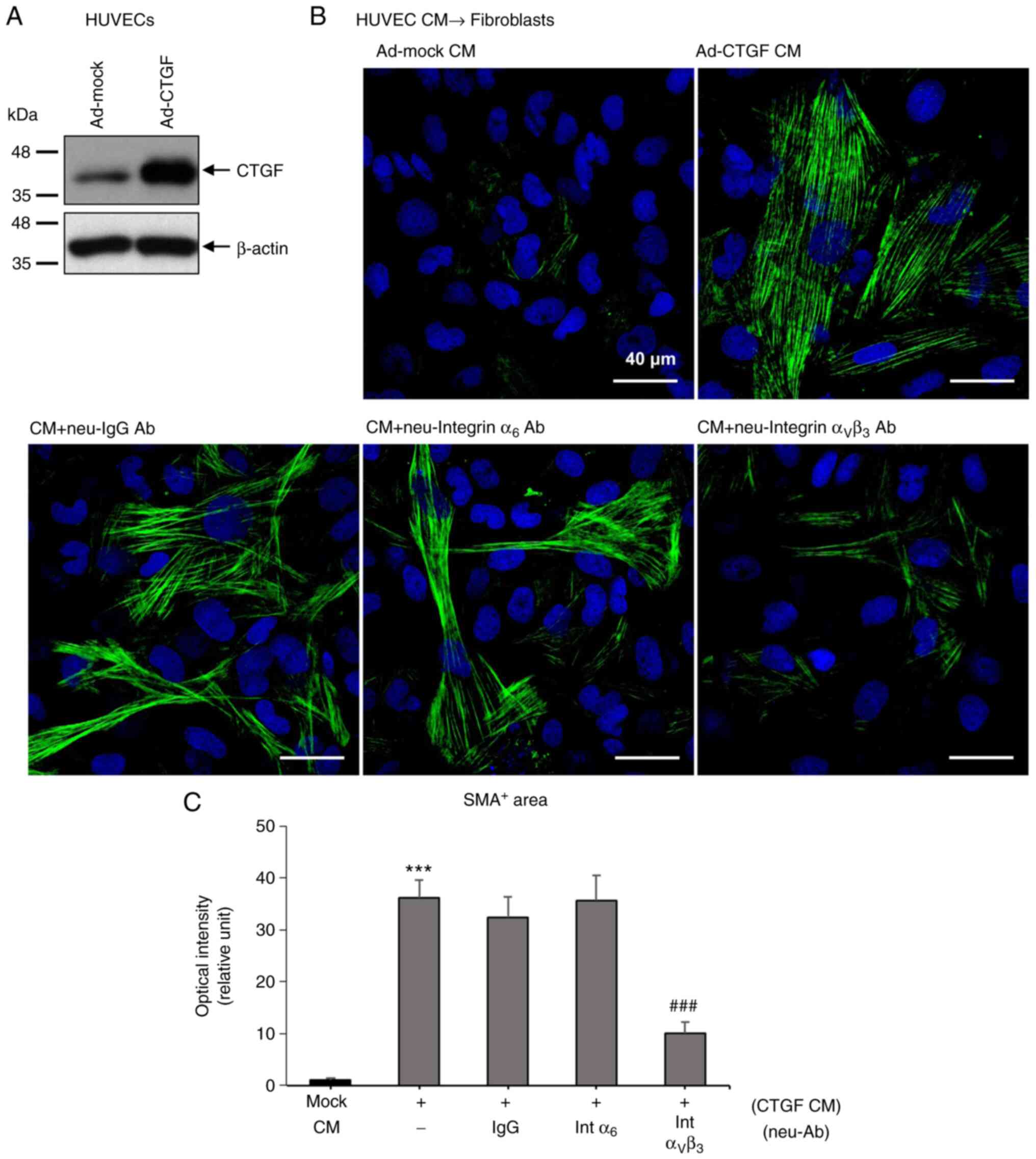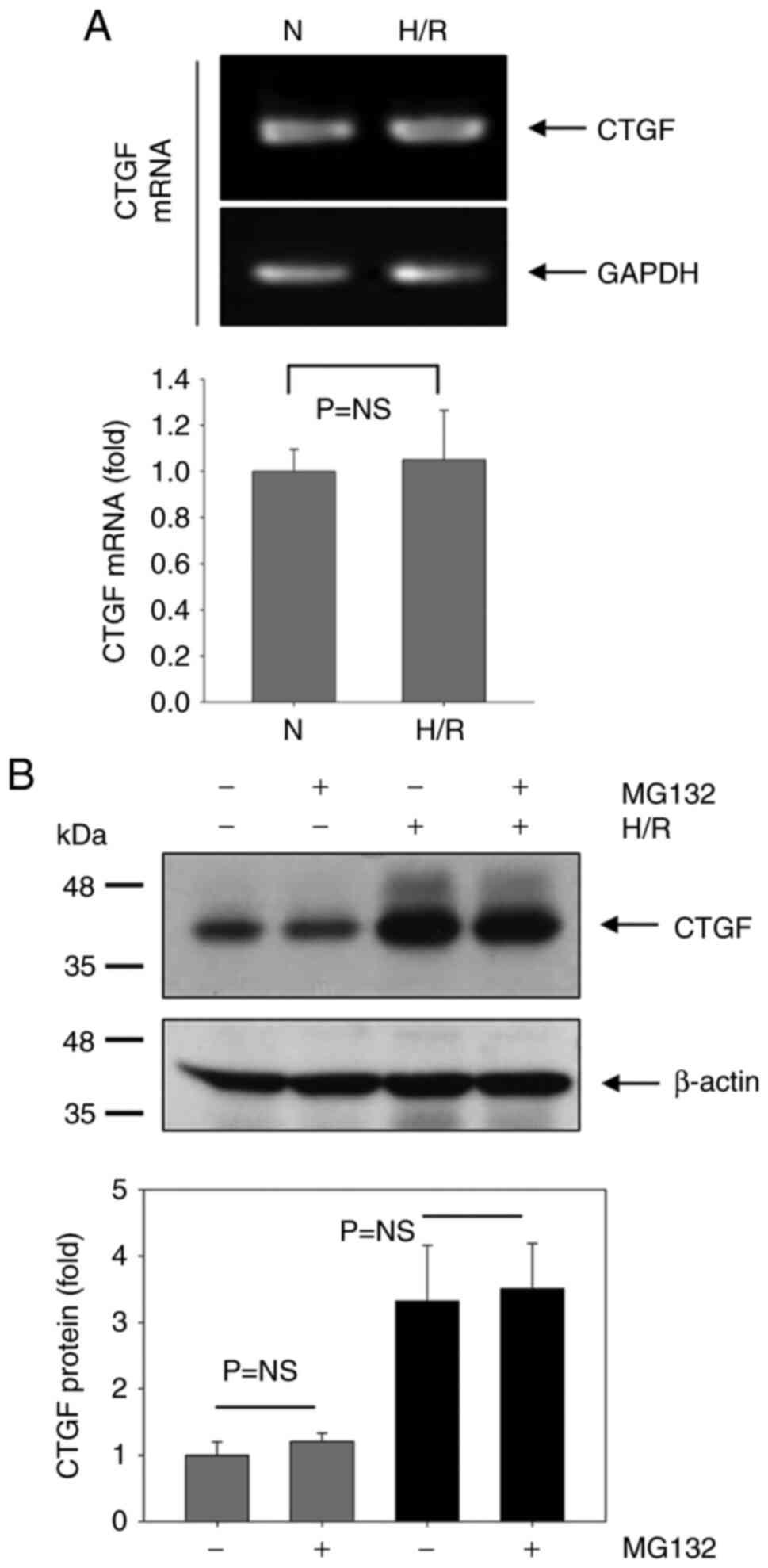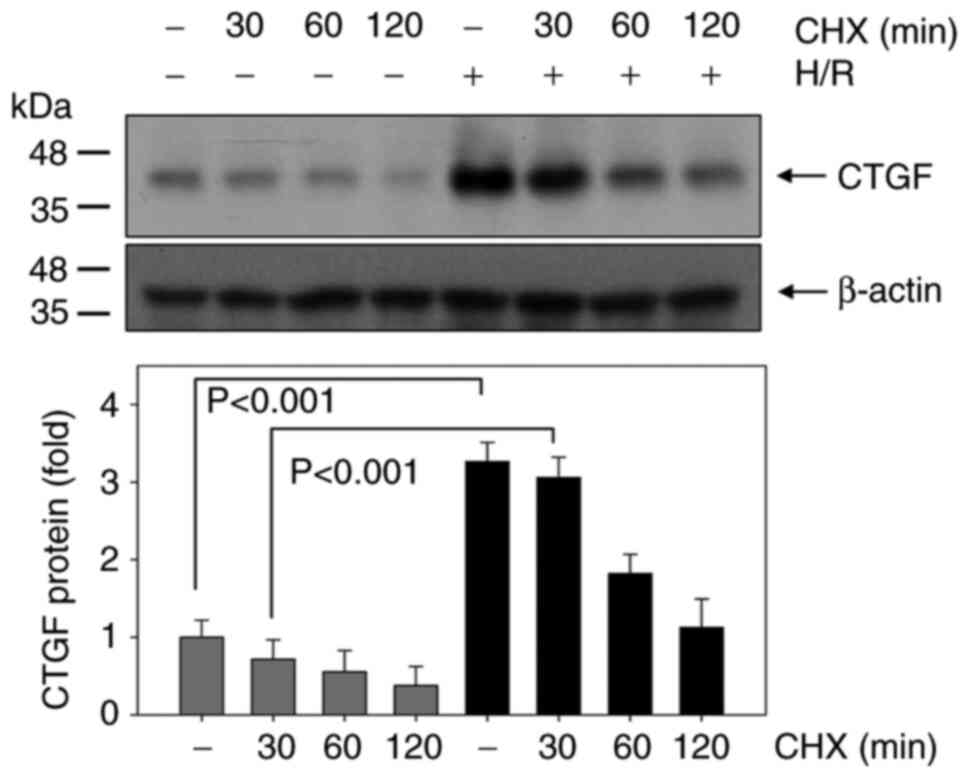|
1
|
Servais C and Erez N: From sentinel cells
to inflammatory culprits: Cancer-associated fibroblasts in
tumour-related inflammation. J Pathol. 229:198–207. 2013.PubMed/NCBI View Article : Google Scholar
|
|
2
|
McAnulty RJ: Fibroblasts and
myofibroblasts: Their source, function and role in disease. Int J
Biochem Cell Biol. 39:666–671. 2007.PubMed/NCBI View Article : Google Scholar
|
|
3
|
Otranto M, Sarrazy V, Bonte F, Hinz B,
Gabbiani G and Desmouliere A: The role of the myofibroblast in
tumor stroma remodeling. Cell Adh Migr. 6:203–219. 2012.PubMed/NCBI View Article : Google Scholar
|
|
4
|
Tomasek JJ, Gabbiani G, Hinz B, Chaponnier
C and Brown RA: Myofibroblasts and mechano-regulation of connective
tissue remodelling. Nat Rev Mol Cell Biol. 3:349–363.
2002.PubMed/NCBI View
Article : Google Scholar
|
|
5
|
Schafer M and Werner S: Cancer as an
overhealing wound: An old hypothesis revisited. Nat Rev Mol Cell
Biol. 9:628–638. 2008.PubMed/NCBI View
Article : Google Scholar
|
|
6
|
Kalluri R: The biology and function of
fibroblasts in cancer. Nat Rev Cancer. 16:582–598. 2016.PubMed/NCBI View Article : Google Scholar
|
|
7
|
Ziani L, Chouaib S and Thiery J:
Alteration of the antitumor immune response by cancer-associated
fibroblasts. Front Immunol. 9(414)2018.PubMed/NCBI View Article : Google Scholar
|
|
8
|
Kobayashi H, Enomoto A, Woods SL, Burt AD,
Takahashi M and Worthley DL: Cancer-associated fibroblasts in
gastrointestinal cancer. Nat Rev Gastroenterol Hepatol. 16:282–295.
2019.PubMed/NCBI View Article : Google Scholar
|
|
9
|
Leask A: Potential therapeutic targets for
cardiac fibrosis: TGFbeta, angiotensin, endothelin, CCN2, and PDGF,
partners in fibroblast activation. Circ Res. 106:1675–1680.
2010.PubMed/NCBI View Article : Google Scholar
|
|
10
|
Chen Z, Zhang N, Chu HY, Yu Y, Zhang ZK,
Zhang G and Zhang BT: Connective tissue growth factor: From
molecular understandings to drug discovery. Front Cell Dev Biol.
8(593269)2020.PubMed/NCBI View Article : Google Scholar
|
|
11
|
Bradham DM, Igarashi A, Potter RL and
Grotendorst GR: Connective tissue growth factor: A cysteine-rich
mitogen secreted by human vascular endothelial cells is related to
the SRC-induced immediate early gene product CEF-10. J Cell Biol.
114:1285–1294. 1991.PubMed/NCBI View Article : Google Scholar
|
|
12
|
Chuva de Sousa Lopes SM, Feijen A, Korving
J, Korchynskyi O, Larsson J, Karlsson S, ten Dijke P, Lyons KM,
Goldschmeding R, Doevendans P and Mummery CL: Connective tissue
growth factor expression and Smad signaling during mouse heart
development and myocardial infarction. Dev Dyn. 231:542–550.
2004.PubMed/NCBI View Article : Google Scholar
|
|
13
|
Gao R and Brigstock DR: Connective tissue
growth factor (CCN2) induces adhesion of rat activated hepatic
stellate cells by binding of its C-terminal domain to integrin
alpha(v)beta(3) and heparan sulfate proteoglycan. J Biol Chem.
279:8848–8855. 2004.PubMed/NCBI View Article : Google Scholar
|
|
14
|
Heng EC, Huang Y, Black SA Jr and Trackman
PC: CCN2, connective tissue growth factor, stimulates collagen
deposition by gingival fibroblasts via module 3 and alpha6- and
beta1 integrins. J Cell Biochem. 98:409–420. 2006.PubMed/NCBI View Article : Google Scholar
|
|
15
|
Morrison BL, Jose CC and Cutler ML:
Connective Tissue Growth Factor (CTGF/CCN2) enhances lactogenic
differentiation of mammary epithelial cells via integrin-mediated
cell adhesion. BMC Cell Biol. 11(35)2010.PubMed/NCBI View Article : Google Scholar
|
|
16
|
Becker TC, Noel RJ, Coats WS, Gómez-Foix
AM, Alam T, Gerard RD and Newgard CB: Use of recombinant adenovirus
for metabolic engineering of mammalian cells. Methods Cell Biol.
43:161–189. 1994.PubMed/NCBI View Article : Google Scholar
|
|
17
|
He TC, Zhou S, da Costa LT, Yu J, Kinzler
KW and Vogelstein B: A simplified system for generating recombinant
adenoviruses. Proc Natl Acad Sci USA. 95:2509–2514. 1998.PubMed/NCBI View Article : Google Scholar
|
|
18
|
Smith RC, Branellec D, Gorski DH, Guo K,
Perlman H, Dedieu JF, Pastore C, Mahfoudi A, Denèfle P, Isner JM
and Walsh K: p21CIP1-mediated inhibition of cell proliferation by
overexpression of the gax homeodomain gene. Genes Dev.
11:1674–1689. 1997.PubMed/NCBI View Article : Google Scholar
|
|
19
|
Deng YZ, Chen PP, Wang Y, Yin D, Koeffler
HP, Li B, Tong XJ and Xie D: Connective tissue growth factor is
overexpressed in esophageal squamous cell carcinoma and promotes
tumorigenicity through beta-catenin-T-cell factor/Lef signaling. J
Biol Chem. 282:36571–36581. 2007.PubMed/NCBI View Article : Google Scholar
|
|
20
|
Zhou Y, Capuco AV and Jiang H: Involvement
of connective tissue growth factor (CTGF) in insulin-like growth
factor-I (IGF1) stimulation of proliferation of a bovine mammary
epithelial cell line. Domest Anim Endocrinol. 35:180–189.
2008.PubMed/NCBI View Article : Google Scholar
|
|
21
|
Rehn M, Veikkola T, Kukk-Valdre E,
Nakamura H, Ilmonen M, Lombardo C, Pihlajaniemi T, Alitalo K and
Vuori K: Interaction of endostatin with integrins implicated in
angiogenesis. Proc Natl Acad Sci. USA. 98:1024–1029.
2001.PubMed/NCBI View Article : Google Scholar
|
|
22
|
Ma W, Tavakoli T, Derby E, Serebryakova Y,
Rao MS and Mattson MP: Cell-extracellular matrix interactions
regulate neural differentiation of human embryonic stem cells. BMC
Dev Biol. 8(90)2008.PubMed/NCBI View Article : Google Scholar
|
|
23
|
Lee SW, Won JY, Kim WJ, Lee J, Kim KH,
Youn SW, Kim JY, Lee EJ, Kim YJ, Kim KW and Kim HS: Snail as a
potential target molecule in cardiac fibrosis: Paracrine action of
endothelial cells on fibroblasts through snail and CTGF axis. Mol
Ther. 21:1767–1777. 2013.PubMed/NCBI View Article : Google Scholar
|
|
24
|
Murakami M, Ernsting MJ, Undzys E, Holwell
N, Foltz WD and Li SD: Docetaxel conjugate nanoparticles that
target α-smooth muscle actin-expressing stromal cells suppress
breast cancer metastasis. Cancer Res. 73:4862–4871. 2013.PubMed/NCBI View Article : Google Scholar
|
|
25
|
Ozdemir BC, Pentcheva-Hoang T, Carstens
JL, Zheng X, Wu CC, Simpson TR, Laklai H, Sugimoto H, Kahlert C,
Novitskiy SV, et al: Depletion of carcinoma-associated fibroblasts
and fibrosis induces immunosuppression and accelerates pancreas
cancer with reduced survival. Cancer Cell. 28:831–833.
2015.PubMed/NCBI View Article : Google Scholar
|
|
26
|
Zalcman G, Mazieres J, Margery J,
Greillier L, Audigier-Valette C, Moro-Sibilot D, Molinier O, Corre
R, Monnet I, Gounant V, et al: Bevacizumab for newly diagnosed
pleural mesothelioma in the Mesothelioma Avastin Cisplatin
Pemetrexed Study (MAPS): A randomised, controlled, open-label,
phase 3 trial. Lancet. 387:1405–1414. 2016.PubMed/NCBI View Article : Google Scholar
|
|
27
|
Ramazani Y, Knops N, Elmonem MA, Nguyen
TQ, Arcolino FO, van den Heuvel L, Levtchenko E, Kuypers D and
Goldschmeding R: Connective tissue growth factor (CTGF) from basics
to clinics. Matrix Biol. 68-69:44–66. 2018.PubMed/NCBI View Article : Google Scholar
|
|
28
|
Chien W, Yin D, Gui D, Mori A, Frank JM,
Said J, Kusuanco D, Marchevsky A, McKenna R and Koeffler HP:
Suppression of cell proliferation and signaling transduction by
connective tissue growth factor in non-small cell lung cancer
cells. Mol Cancer Res. 4:591–598. 2006.PubMed/NCBI View Article : Google Scholar
|
|
29
|
Jun JI and Lau LF: Taking aim at the
extracellular matrix: CCN proteins as emerging therapeutic targets.
Nat Rev Drug Discov. 10:945–963. 2011.PubMed/NCBI View Article : Google Scholar
|
|
30
|
Chen CC, Chen N and Lau LF: The angiogenic
factors Cyr61 and connective tissue growth factor induce adhesive
signaling in primary human skin fibroblasts. J Biol Chem.
276:10443–10452. 2001.PubMed/NCBI View Article : Google Scholar
|
|
31
|
Gao R and Brigstock DR: A novel integrin
alpha5beta1 binding domain in module 4 of connective tissue growth
factor (CCN2/CTGF) promotes adhesion and migration of activated
pancreatic stellate cells. Gut. 55:856–862. 2006.PubMed/NCBI View Article : Google Scholar
|
|
32
|
Naska S, Park KJ, Hannigan GE, Dedhar S,
Miller FD and Kaplan DR: An essential role for the integrin-linked
kinase-glycogen synthase kinase-3 beta pathway during dendrite
initiation and growth. J Neurosci. 26:13344–13356. 2006.PubMed/NCBI View Article : Google Scholar
|
|
33
|
Avalos AM, Valdivia AD, Muñoz N,
Herrera-Molina R, Tapia JC, Lavandero S, Chiong M, Burridge K,
Schneider P, Quest AF and Leyton L: Neuronal Thy-1 induces
astrocyte adhesion by engaging syndecan-4 in a cooperative
interaction with alphavbeta3 integrin that activates PKCalpha and
RhoA. J Cell Sci. 122:3462–3471. 2009.PubMed/NCBI View Article : Google Scholar
|
|
34
|
He Y, Zou P, Lu Y, Jia D, Li X, Yang H,
Tang L, Zhu Z, Tu T, Tai S, et al: Osteoprotegerin promotes intimal
hyperplasia and contributes to in-stent restenosis: Role of an
αVβ3/FAK dependent YAP pathway. J Mol Cell Cardiol. 139:1–13.
2020.PubMed/NCBI View Article : Google Scholar
|
|
35
|
Steffen CL, Ball-Mirth DK, Harding PA,
Bhattacharyya N, Pillai S and Brigstock DR: Characterization of
cell-associated and soluble forms of connective tissue growth
factor (CTGF) produced by fibroblast cells in vitro. Growth
Factors. 15:199–213. 1998.PubMed/NCBI View Article : Google Scholar
|
|
36
|
Boes M, Dake BL, Booth BA, Erondu NE, Oh
Y, Hwa V, Rosenfeld R and Bar RS: Connective tissue growth factor
(IGFBP-rP2) expression and regulation in cultured bovine
endothelial cells. Endocrinology. 140:1575–1580. 1999.PubMed/NCBI View Article : Google Scholar
|
|
37
|
Hahn A, Heusinger-Ribeiro J, Lanz T,
Zenkel S and Goppelt-Struebe M: Induction of connective tissue
growth factor by activation of heptahelical receptors. Modulation
by Rho proteins and the actin cytoskeleton. J Biol Chem.
275:37429–37435. 2000.PubMed/NCBI View Article : Google Scholar
|















